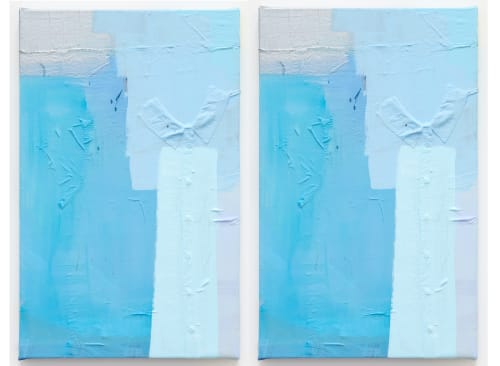The last time I visited a Sadie Laska exhibit, I was extremely impressed with her subtly mixing in the sculptural medium and the rendering of her cloud motif. The latest show incorporates fabric into the painting. You notice this immediately in the blue painting with a shirt pressed into it, from here you’re able to realize it in the rest of the paintings. Obviously the use of a shirt in some ways continues Laska’s project of incorporating the sculptural or blurring the line between painting and sculpture. However, in this case, Laska seems more concerned with taking an object and pressing it very tightly into the canvas and painting over it in such a way that it is subsumed into the painting. The effect is quite seamless and stunning. The wrinkles in the shirt become almost indistinguishable from a painterly impasto.
Laska does not only paint over the fabric in order to meld it into the painting. In another work, she allows the fabric’s native patterns to form part of the painting’s composition, thereby melding it into the painting by hiding it in plain sight (for lack of a better phrase).
There are several instances where Laska uses strips from a red and blue plaid laundry bag. This is the only fabric that is left immediately recognizable. For me these bags form the counterpoint to the now omnipresent Ikea bags, and thus can be employed as a counterpoint to all that Ikea represents, particularly for a New York City-based painter, who must be aware of and affected by issues of corporatization and gentrification.
After sitting (or more accurately, standing) with the paintings for a minute you come to notice and be affected by the field of grey that seems to hide in the background, forming the neutral default color for the series; In one painting it dominates just slightly more than half the canvas — threatening to encroach — but it is present throughout. The grey adds a sense of gravitas that lurks behind the colors, the patterns and the play with fabrics. This sense of metallic menace has a very thrilling sort of appeal.
Situated behind the Michael Stipe exhibit, you will find the four untitled paintings in a smaller room that Journal Gallery has dubbed “Tennis Elbow.” I was thrilled to find Laska included, as Tennis Elbow consistently shows painters who innovate painting, finding ways to keep the medium relevant. More specifically, painters whose innovation eschews attempts to shock you with extra bold formal flavor, but rather reward your patient consideration. Perhaps the room is small in order to conduce such consideration. Laska epitomizes such a painter in my eyes, and thus it is very satisfying to see her new work in the Tennis Elbow space.
July 16, 2018

